
Page and Lake Powell Visitors Guide
One of the highlights of any Southwest vacation or road trip is a visit to Lake Powell. America's second largest reservoir, located in the 1.25 million acre Glen Canyon National Recreation Area, is a natural wonder that straddles a remote and beautiful landscape.
The area, which stretches for hundreds of miles from Lees Ferry in Arizona to the Orange Cliffs of southern Utah, offers unparalleled opportunities for water-based, hiking, camping, air tours, and backcountry recreation.
The lake's namesake, Major John Wesley Powell, famously mapped the last unknown corner of the West by rowing the Colorado River in 1869. He described otherworldly Glen Canyon as the "ensemble of wonderful features-carved walls, royal arches, glens, alcove gulches, mounds and monuments."
The canyon complex then became America's second largest reservoir with the completion of the Glen Canyon Dam in 1963. The massive 710-feet high dam filled the serpentine network of canyons with 500 feet of water, creating 1,900 miles of shoreline.
The lake has become the playground of the Colorado River and still covers the region's remote slick rock canyons and orange sandstone nooks, despite the Lake Powell water level receding rapidly due to the ongoing drought plaguing the Southwest.
Lake Powell is a playground like no place else on earth. And in this guide we will cover the best places, activities, and tours the region has to offer.
Where Is Lake Powell Located?
Lake Powell is located in northern Arizona and the massive reservoir extends up into southern Utah. It is next to Page, Arizona and is about 135 miles from Flagstaff, Arizona, 200 miles from Grand Canyon's South Rim, and 300 miles from Las Vegas, NV. It's part of the Colorado River in Glen Canyon National Recreation Area, the massive 1.25 million acre playground with an assortment of exciting water and land based activities.
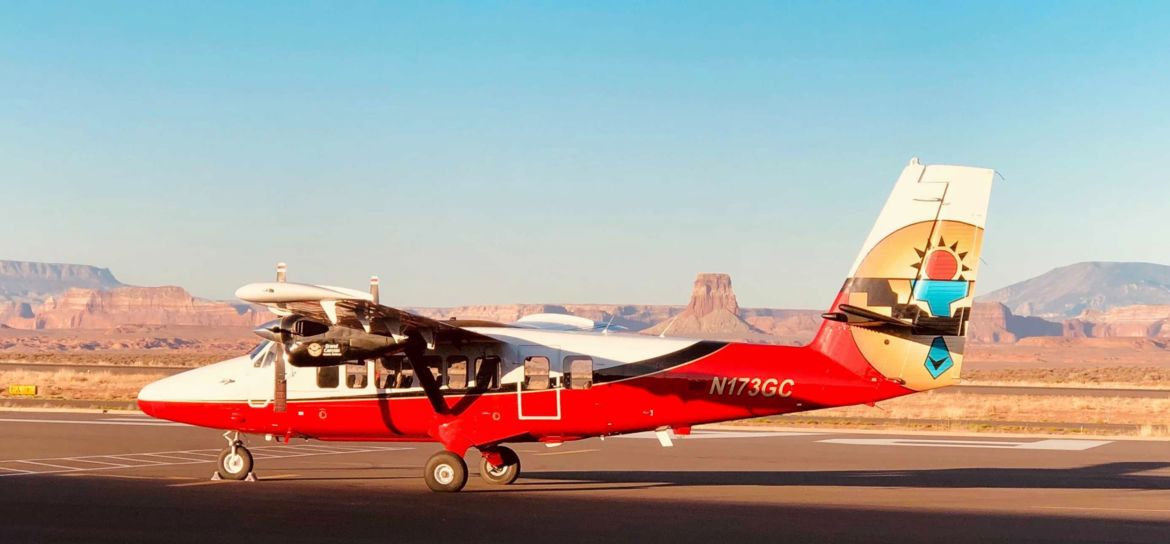
How To Get to Lake Powell
Here are a few ways to travel to Lake Powell. The most direct, which provides visitors more time to explore the region, is a flight to Page, AZ from Las Vegas aboard a Papillon airplane flight. Las Vegas to Page AZ flights leave daily and connect you to popular package tours to the most stunning destinations in the region such as Horseshoe Bend and Antelope Canyon.
Other ways to arrive to Lake Powell include driving from Las Vegas, Grand Canyon, and other Southwest destinations, such as Phoenix. But these are long, grueling drives through the remote desert.
For example, from Las Vegas to Lake Powell travelers must endure a 310-mile, 7.5 hour drive.
There is no public transportation that serves Page, Arizona.
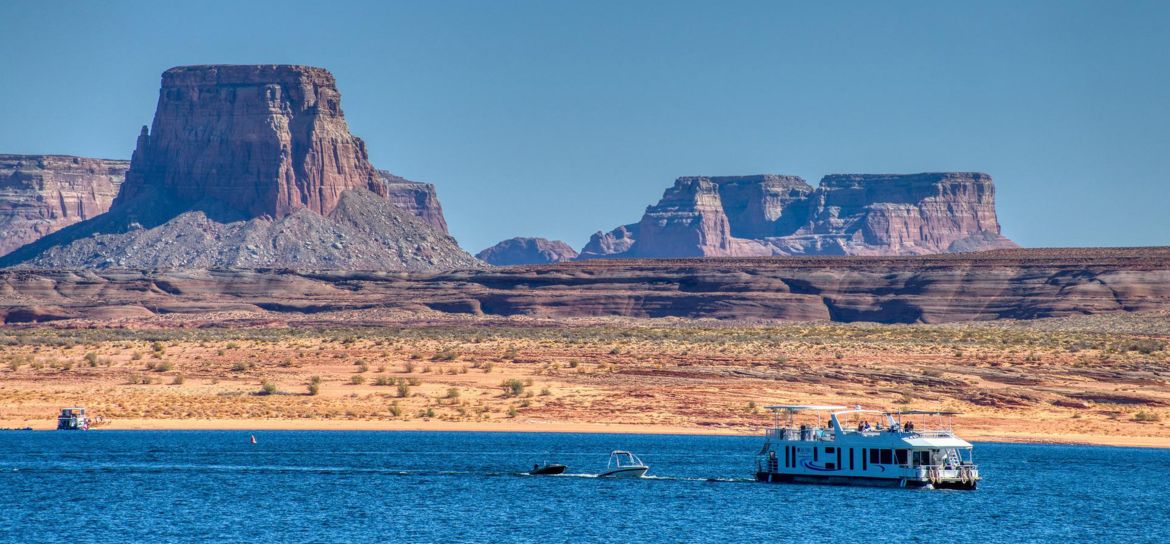
Lake Powell Houseboat Rentals
The lake itself is the main attraction in this arid region. And the most popular activity is renting a boat for the day or a houseboat for an overnight adventure.
Houseboats are large, live-in flat-bottomed power boats with square sides and house-like characteristics.
The two main marinas offer the most amenities for all travelers. Wahweap Marina, at Lake Powell Resort near Page, AZ, is located just south of the Arizona state border, and the Bullfrog Marina, located in Utah five hours north from Wahweap, are full service locations. A third, Halls Crossing Marina, is located in Utah and offers a limited selection of watercraft and amenities.
At these marinas you can rent:
- 23-ft pontoon boats (available at Bullfrog & Wahweap).
- 21-ft powerboats (available at Wahweap).
- 19-ft powerboats (available at Bullfrog, Wahweap, and Halls Crossing).
- Jet skis (available at Bullfrog, Wahweap, and Halls Crossing).
- Weekender boats (available at Wahweap only) for the ultimate home base for up to 12 guests.

Lake Powell Boat Tours
If you prefer to just sit back, relax, and soak in views, then take a scenic boat tour on Lake Powell. This option avoids having to rent a boat and plan your own logistics.
Just show up and sail the lake with other visitors from all over the world! Most boat tours depart from Wahweap Marina at Lake Powell Resort near Page, AZ.
The most popular tours and destinations are:
- The two-hour Panoramic Lake Powell Tour sails you to Gunsight Bay, located at mile 19 and named for Gunsight Butte (4,678 feet) and surrounding areas.
- Boat tours to Rainbow Bridge, one of the world's highest natural bridges, are available from the park's concessioner, Lake Powell Resorts & Marinas. Tours depart from Wahweap and guests travel about 50 miles on the lake to arrive at Rainbow Bridge. The tour is an all day excursion.
Boat tours also include time spent on Padre Bay, the largest bay on Lake Powell, which is also the largest expanse of open water in the region. This bay, seven miles across and nine miles long, is also one of the most scenic, with spectacular views of monuments such as Domingues Butte, Tower Butte, Cookie Jar Butte, and the aptly-named Boundary Butte, which straddles both Utah and Arizona.

Hiking Rainbow Bridge and Other Lake Powell Trails
There is world class hiking all around the Lake Powell region, but nothing is more rewarding than a trek to Rainbow Bridge, one of the most famous hikes located in the Southwest. Rainbow Bridge, located in the magnificent Navajo Nation, is one of the world's highest natural bridges at 290 feet high and has an incredible 275 foot span.
There are two ways to hike to Rainbow Bridge:
- The rugged, unmarked 17.5 mile Rainbow Bridge North Trail begins on the north side of Navajo Mountain, and winds through several canyons before following the cliff-lined Rainbow Bridge Canyon to the iconic natural bridge.
- The unmaintained, 16-mile Rainbow Bridge South Trail is a very adventurous hike (32-mile round-trip) for experienced desert travelers only that includes nearly 8,500 feet in elevation gain. It begins at the southern edge of Navajo Mountain and a half-mile south of the Utah-Arizona border. You travel through three canyons to Yabut Pass, descend into Cliff Canyon, then climb through Redbud Pass to Rainbow Bridge Canyon.
Typically the best months to complete this hike are March through mid-May, and October and November.
Since both trails are located on Navajo lands, a permit is required for hiking and camping, though no camping is allowed in Rainbow Bridge National Monument proper. You can obtain a permit from the Navajo Nation Parks and Recreation Department in Window Rock, Arizona at 928-871-6647. The National Park Service recommends not parking at either trailhead but instead hiring a local Navajo to drop you off and pick you up after the hike.
Other famous hikes are clustered off Hole in the Rock road, a 55 mile long four-wheel drive road. They include:
- Coyote Gulch and Hurricane Wash Loop - a 25-mile gem that features the 4th largest arch in the world, huge natural amphitheaters, petroglyphs, and year round rivers.
- Broken Bow Arch - 6.3-mile out-and-back trail near Lake Powell that ends at a beautiful nature arch.
The unlimited shoreline of Lake Powell also serves up fantastic hiking opportunities as well. A few trails worth exploring in the region include:
- Navajo Canyon, a 12 mile round trip narrow slot canyon (similar to Antelope Canyon) that is the longest side canyon on Lake Powell that is not a river arm.
- Labyrinth Canyon, located at mile 16 near Padre Bay of Lake Powell, where you can take a kayak, stand up paddleboard, or small watercraft to navigate up the narrow canyon.
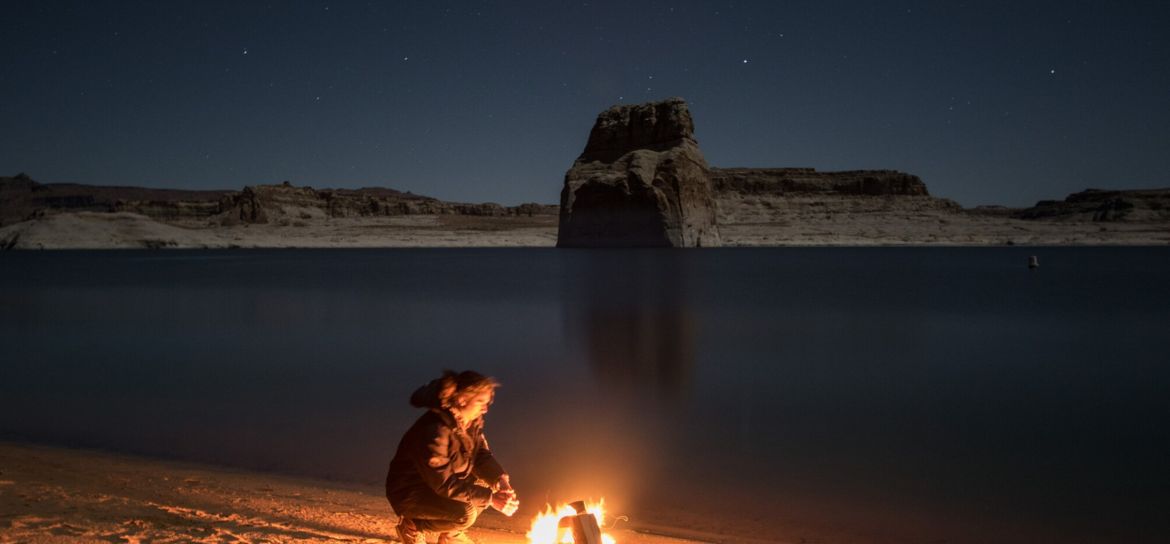
Lake Powell Camping
The vastness of 1,9000 miles of shoreline affords visitors a wide variety of options when it comes to both established and backcountry Lake Powell camping sites.
First, you can camp anywhere on the shorelines of Lake Powell except in developed marinas. And dispersed camping is allowed throughout Glen Canyon's massive backcountry.
There are just a few rules; camping is limited to 14 consecutive days and no more than 30 days total in the park in any calendar year. In campgrounds with designated sites there is a maximum of eight people per individual designated site. If you have more, look for a designated group site.
The popular areas along the river between Glen Canyon Dam and Lees Ferry limit camping to five designated first-come, first-served areas. A permit is required from Grand Canyon National Park to float this section of the river and camp here.
The largest campground on Lake Powell is Wahweap Campground & RV Park. It offers 112 dry campsites (no hook-ups), 90 full hook-ups, and six group camping sites. Facilities include restrooms, laundry, showers, a general store, dump station and potable water. An amphitheater, picnic area, and swim beach are also nearby. To make reservations for full hook-ups, group or dry camping please visit www.lakepowell.com or call 800-528-6154.

Lake Powell National Park Service Campgrounds:
The national park also operates four campgrounds on its own. These campgrounds do not take reservations and do not have phone numbers. They are:
- Lees Ferry Campground ($20 per site/per night. 54 designated sites. No hookups. RV dump station. Grills provided, no open fires.)
- Beehives Campground - ($14 per night. Six designated sites. Across the highway from Wahweap South Entrance. Picnic table at each site. No hookups, dump station, or restrooms.)
- Lone Rock Beach Primitive Camping Area ($14 per vehicle/per night. Primitive camping).
- Stanton Creek Primitive Camping Area (Designated primitive camping areas that are accessible by vehicle and sometimes by boat. First-come first served. No potable water.)
Non-National Park Service Campgrounds In Lake Powell
The national park has two additional campgrounds, besides Wahweap Campground & RV Park, at Lake Powell that are operated by concessionaires. They are:
- Bullfrog RV & Campground (98 sites, 18 with electric hook ups) restroom, dump station, potable water.
- Halls Crossing RV & Campground - (72 total sites, 31 with electric hook-ups. RV only, 41 tent only).

Other Things To See and Do Around Lake Powell
Here's a secret about Lake Powell - it's even more beautiful from the sky. Check out a full list of tours starting from the Page, Arizona airport that allow you to have the ultimate views of canyon country from above.

Horseshoe Bend Air Tours
These tours include the Horseshoe Bend Air Tour.
Horseshoe Bend, a stunning 270-degree bend in the Colorado River that offers photographers one of the most colorful and dramatic panorama's in the world, is a very popular day tour in the region.
You'll join other hikers at a panoramic view of a 1000 foot overlook down into the Colorado River. The hike is about .6 miles one-way to the overlook.
There are also private Horseshoe Bend Flightseeing Tour that combine trips to Antelope Canyon and can also offer you a less-frequented vista over this photogenic panorama.
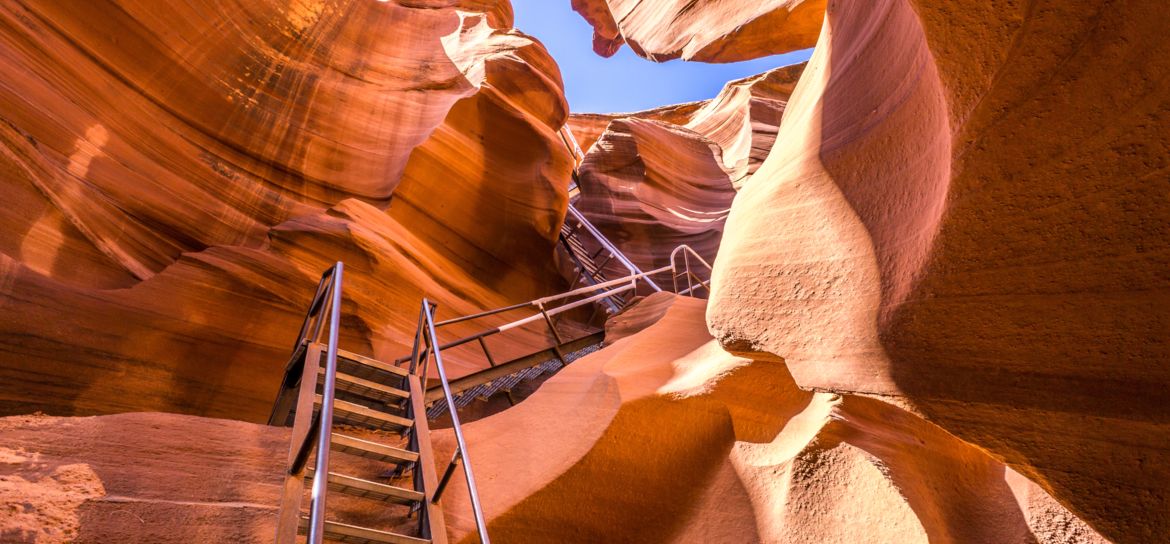
Antelope Canyon Tours
One of the most spectacular slot canyons in the world, Antelope Canyon, is adjacent to Lake Powell. This collection of winding canyon corridors, massive sandstone rooms, and dancing sunlight is a jewel of the Navajo Nation.
Discover the wonders of this mystical destination on your own or as part of a larger tour of the region, such as the Las Vegas To Antelope Canyon tour.
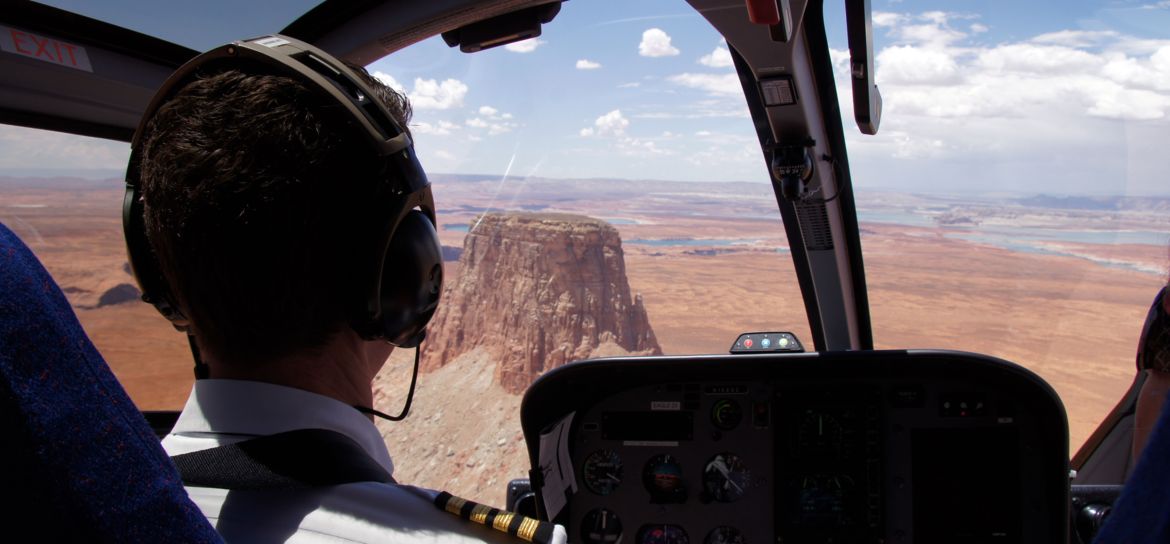
Tower Butte Helicopter Landing
For a real adventure, try Papillon's Tower Butte Landing tour.
This amazing experience, just nine miles northeast of Page, AZ, has you landing on a 5,287-foot sandstone monolith called Tower Butte that dominates over the landscape and offers 360-degree panoramic views of the Glen Canyon National Recreation Area, Lake Powell, and Navajo Mountain.
If you are looking for the ultimate, unique adventure experience, this is it! Papillon is the only helicopter operator permitted to land atop Tower Butte.
Lake Powell is also a great jumping off point for rafting on the Colorado River.
Family friendly, gentle floats of a 15-mile stretch of river through Glen Canyon are popular in this area and give visitors an immersive way to take in the grandeur of this section of canyon country. On these trips, you'll travel in a motorized river raft passing sheer, colorful canyon walls and see a variety of wildlife ranging from fish, to birds, to large mammals such as big horn sheep.
You'll hike to see ancient Native American petroglyphs on remote beaches, raft through Horseshoe Bend, and continue through Marble Canyon, which marks the beginning of the Grand Canyon. Your trip will come to an end at historic Lees Ferry where ground transportation will be waiting for your return trip.

Lake Powell Water Level
The massive hydrological event that took place when the Glen Canyon dam was being built, sadly, is reversing itself. It took 17 years to cover Glen Canyon with 500 feet of water and the Southwest's mega-drought over the past two decades has steadily lowered water levels.
All around Lake Powell is the visible reminder that the water level of the mighty reservoir has receded dramatically over the last decade. The band of white minerals, known as the "bathtub ring" that have stuck to the sandstone bowl, is now as high as the Statue of Liberty, some 300 feet tall, in places.
Lake Powell water levels have drifted lower during the prolonged drought in the Southwest. Due to this, some boat ramps are now closed due to low water levels. Some areas have smaller navigation channels, which lead to more boats in a smaller area. Boaters should remember that, as water levels drop, caution should be exercised in all areas of the lake..
Some regions of Lake Powell have changed, perhaps forever, due to the lower water levels. At the far reaches of the northern part of the reservoir The Hite Ranger Station area has now closed all of its launch ramps due to record-low water levels. Dangling Rope Marina, a refueling station marina that serviced a 100-mile stretch of Lake Powell, is also closed as a result of low water levels.
Places you used to take a boat directly up to, such as La Gorce Arch in the Escalante Arm of Davis Gulch are now completely inaccessible unless you hike in. In some lakefront outposts, dry-docked boats populate the shoreline, a testament to the receding shoreline.
But the receding lake levels have also opened up new places to explore and Glen Canyon is beginning to emerge, again. Remote locations and canyons that were flooded when the Glen Canyon Dam filled the reservoir are now accessible and the shoreline is always evolving.
Edward Abbey, who was one of several writers and artists to float through Glen Canyon shortly before its inundation, called the closing of the dam's gates a "crime." To grasp the nature of this crime, he wrote, "imagine the Taj Mahal or Chartres Cathedral buried in mud until only the spires remain visible." As the beauty of the buried treasures that lie throughout Glenn Canyon once again emerge, there is no better time to visit this magical place.
Plan Your Lake Powell Vacation: Q&A
What fun activities are there for children when visiting Lake Powell?
The free tour of Glen Canyon Dam is educational and a must for children. The John Wesley Powell Museum, in Page, Arizona, honoring the first Colorado River Grand Canyon exploration leader is another great educational stop. The short hike to Horseshoe Bend is a rewarding day trip for the entire family.
When is the best time to visit Lake Powell?
Conditions are ideal in Fall. In the Fall (September-October) visitors experience warm water and cooler temperatures. Summer (June- August) is the busiest time with long, warm days and even warmer water.
How much time do I need to visit Lake Powell?
For a visit to Lake Powell, in order to experience all the region has to offer (water, land, canyon, and river excursions), you’ll need 3-5 days for an unrushed, rewarding travel experience.
Can you swim in Lake Powell?
In the summer, it is common for the lake temperature to exceed 80 degrees, making Lake Powell a perfect place to swim. With more than 19,000 miles of shoreline, many accessible via backroads and short hikes, you don’t need a boat to enjoy this world class destination.
What is the prettiest part of Lake Powell?
Padre Bay, the largest bay on Lake Powell, provides visitors with an amazing panorama of scenic monuments that is seven miles across and nine miles long.
What is Lake Powell’s current water level?
Lake Powell water level data is available in real time at lakepowell.water-data.com. This water database provides a water summary, latest elevation readings, and inflow data to help plan your trip accordingly.
Is Lake Powell too low for houseboats?
No, Lake Powell has two full-service marinas that rent houseboats and the water level of the lake still allows for pontoon boats, powerboats, and houseboats rentals. Check with Wahweap Marina at Lake Powell Resort near Page, AZ for the most options.